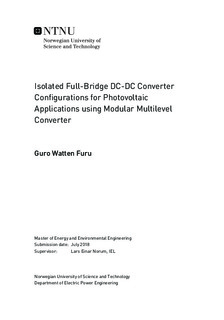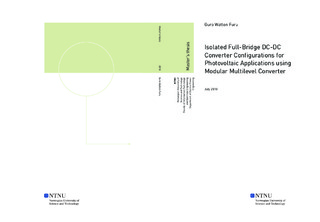| dc.description.abstract | As a result of the continuously increasing carbon emissions, the global demand for cleaner energy is rising. Grid-connected photovoltaic (PV) systems is an attractive solution to provide green energy, and PV technology has therefore gained increased attention which has resulted in higher efficiency PV panels. PV plants have benefited with increased annual energy yield, and the never before has solar energy contributed with more new power capacity to the power grid. However, variable power production due to unpredictable weather conditions pose a challenge for optimal planning, grid operation, and grid stability.
A replacement of the classic inverter with Modular Multilevel Converter (MMC) got introduced as an attractive topology for PV plants due to a high scalability that facilitates a direct connection to medium voltage grid without the use of a step-up transformer. The required voltage level is achieved by designing the MMC with the correct number of submodules. It also provides high MPPT tracking, which gives the MMC several advantages over conventional PV inverters. The isolation in such a configuration can be provided between the PV strings and the submodules of the MMC by utilizing isolated DC-DC converters.
Different isolated full-bridge DC-DC converter configurations with high efficiency are investigated in this study. The single-unit full-bridge configuration provides a simple structure, but requires high voltage and current ratings due to the high power transfer. By utilizing a parallel- or series-connection of converters, the bulk transmission of power to the submodules is distributed, which increases the overall reliability of the system. If the PV string operating voltage is not equal to the submodule capacitor voltage, then a step-up in voltage is necessary. However, the PV strings are in this study designed such that the HF transformer turns ratio is 1:1 in all configurations.
The parallel-arrangement avoids the parallel-connection of switching devices in the DC-DC converter in order to handle the high currents. SiC MOSFETs have been utilized in the full-bridge due to the high voltage rating. Simulations have been performed at different DC-link voltages, at many different switching frequencies and for the entire operating range of 0.1-1 per unit power in order to find the efficiency. A 50\% reduction in the current through each full-bridge results in a 50\% reduction in the total copper losses. The copper losses are proportional to the square current, and by reducing the current by 50\%, the total copper losses is reduced by 50\%. However, the voltage rating is the same when assuming an unity voltage transformer ratio.
In case of the series-arrangement, the voltage stress on the switching device is reduced considerably. Due to the reduced voltage, an utilization of GaN devices is possible. GaN switching devices have a lower voltage rating than SiC. However, they have shown a superior performance, especially at high-frequency operation. High-frequency operation is beneficial due to reduced size of the HF transformer. The efficiency of the GaN-based series-connected full-bridge DC-DC converter was obtained by calculations of the switching and conduction losses by assuming a worst-case duty ratio of 0.5. The results gave a high efficiency of 98\% for a operating range up to 200 kHz switching.
The obtained efficiency curves were utilized in a simulation model in order to find the overall energy efficiency and the levelized cost of energy (LCOE) of the MMC PV plant configurations. These configurations were also compared to a central inverter (CI) PV configuration and a multi-string central inverter (MSCI) PV configuration in order to state the benefits of utilizing the MMC as inverter in medium voltage PV plants. The MMC topologies, as well as the MSCI topology, provides lower MPPT losses due to the distributed MPPT in comparison with the CI configuration. The MMC configurations had a better energy efficiency for all the different DC-DC converter configurations compared to both the CI and the MSCI configuration.
For the MMC utilizing the single-unit DC-DC configuration, the energy efficiency was obtained to be 95.28\% for the best-case switching frequency at 1 kHz, and 94.40\% for the worst-case switching frequency at 20 kHz. The CI and MSCI efficiency was in comparison 89.63\% and 90.11\% respectively. However, the MMC configurations did not account for losses in the HF transformer in the DC-DC configurations. It was assumed that these losses do not account for a great part of the total losses in the PV plant, and the results would have been almost the same when accounting for them.
For the MMC utilizing a parallel-connection of DC-DC converters, the energy efficiency was obtained to be 95.25\% at 10 kHz switching. In the MMC utilizing the GaN-based series-connection of DC-DC converters, the energy efficiency was calculated to be 95.01\% at 20 kHz switching, and 94.39\% at 200 kHz switching.
The levelized cost of energy (LCOE) was also found for all the different PV configurations. The LCOE was shown to be 6.25\% lower for the MMC utilizing the single-unit DC-DC converter compared to the CI configuration, and 6.21\% and 5.76\% lower for the MMC utilizing the parallel- and series-connection of DC-DC converters respectively. This shows the great benefits of utilizing the MMC instead of the conventional PV inverters.
Another important aspect is that partial shading is not considered in these simulations. The MMC configurations will increase the MPPT substantially, resulting in a even higher extracted energy compared to the CI configuration during partially shaded and non-equalized irradiance conditions in the PV plant. The parallel- and series-connection of DC-DC converters increases the MPPT more than the single-unit DC-DC converter configuration. This will result in a substantially decrease in the LCOE of the MMC PV configurations compared to the CI configuration.
A higher number of series- or parallel-connected DC-DC converter may result in higher efficiency and lower losses, but at the cost of a more complex system and a higher price due to more components. The number of series- and parallel-connected devices must therefore be selected with care.
The simulations on the proposed MMC PV plant configurations verified the improved energy efficiency and the lowered LCOE when utilizing MMC over the CI and the MSCI configurations in medium voltage PV plant applications. | |

